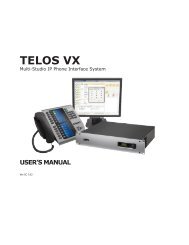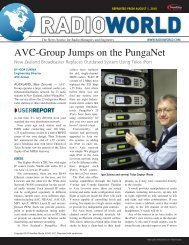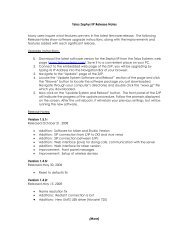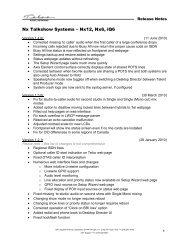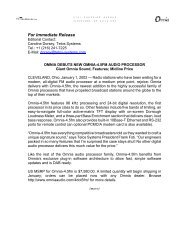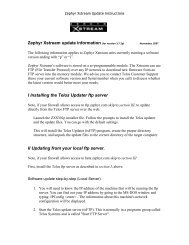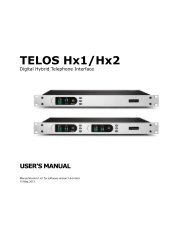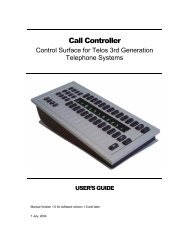NOW! 12-13 - Telos
NOW! 12-13 - Telos
NOW! 12-13 - Telos
You also want an ePaper? Increase the reach of your titles
YUMPU automatically turns print PDFs into web optimized ePapers that Google loves.
AXIA | NETWORKING | TECHNOLOGY ARTICLE<br />
98<br />
AoIP IN BROADCAST ENGINEERING<br />
In early 2004, after months of showing our new baby around,<br />
the irst commercial AoIP studios went on-air at Radio Skonto<br />
in Riga, Latvia, followed closely by Auburn University’s WEGL-FM<br />
in Auburn, Alabama.<br />
After that, acceptance of IP-Audio started growing rapidly.<br />
Broadcasters of all sizes took the plunge, from low-budget college<br />
radio, to privately-owned media operating both single studios<br />
and networks of all sizes, to big public-funded networks.<br />
By 2007 the total number of studios had reached 500, and accelerated<br />
to reach over 3000 active on-air studios equipped<br />
with Livewire by the time of this writing (early 20<strong>12</strong>).<br />
A few notable events, illustrating the scope of this evolution:<br />
» In May, 2005, New York’s WOR became the irst large facil-<br />
ity to select Livewire AoIP, choosing it as the basis for its<br />
new facility on Broadway. WOR installed 7 networked stu-<br />
dios along with several hundred audio sources.<br />
» In 2006, Minnesota Public Radio in Minneapolis/St. Paul<br />
installed 20 networked Axia studios. Also, Radio Free Asia<br />
chose to install Axia in their Bangkok, Thailand news center.<br />
» During the next years a number of other highly reputable<br />
broadcasters chose Axia Livewire too – Clear Channel, RTL,<br />
Univision, Southern California Public Radio, and more. At<br />
the same time, many smaller private and public stations in<br />
the USA, Canada, South America, all parts of Europe, India,<br />
China, Australia, and other countries all around the world<br />
decided to go with AoIP as well.<br />
» In 2009, a fascinating government-funded project in New<br />
Zealand called PungaNet utilized Axia AoIP to cover the<br />
whole island with 21 networked studios, interlinked by<br />
means of MPEG-coded channels and a custom-designed<br />
RTP router.<br />
» Also in 2009, Radio Free Europe/Radio Liberty – one of the<br />
world’s biggest and most reputable broadcasters – went<br />
on air with 50 networked Axia Livewire studios from its new<br />
facility in Prague, in the Czech Republic.<br />
Radio Free Europe<br />
One of 49 Axia studios at Radio Free Europe / Radio Liberty<br />
The steady growth of AoIP didn’t go unnoticed by other equipment<br />
manufacturers, who quickly realized the value of making<br />
their products connect directly with the growing AoIP community.<br />
ENCO Systems was the irst, followed by many other software<br />
and hardware manufacturers, covering a wide product<br />
range that grew to include consoles, sound cards, codecs, various<br />
processing devices and playout systems. In 2010, Nautel<br />
Ltd. announced the Axia Livewire AoIP interface would be included<br />
into one of their transmitter product lines — the “missing<br />
link” that inally made possible an all-AoIP broadcast chain.<br />
A few other companies (after irst denying that the technology<br />
would work) launched their own, proprietary, AoIP solutions.<br />
Unfortunately, none of these are compatible with each other,<br />
or with other broadcast hardware.<br />
But, good news: the value of interoperability between products<br />
from different manufacturers is clearly recognized these days,<br />
and signiicant efforts are currently being applied in that direction<br />
by several organizations.<br />
THE AoIP LANDSCAPE IN 20<strong>12</strong><br />
Today, AoIP has earned wide recognition. This point is driven<br />
home by the multitude of products present on the pro audio<br />
and broadcast market, and in ield, ranging from single devices<br />
up to complete multi-vendor system solutions. There has also<br />
been much attention given by the trade press, including hundreds<br />
of different articles online and in industry magazines.<br />
There is even a book, Audio Over IP: Building Pro AoIP Systems<br />
With Livewire, published by Focal Press/Elsevier.<br />
Along with this attention have come specialized seminars and<br />
conferences on AoIP technologies organized by the Audio Engineering<br />
Society, the NAB, the Society of Broadcast Engineers,<br />
the European Broadcasting Union, and others. There are also<br />
interoperability initiatives and ongoing speciication work at<br />
several private companies and International organizations.<br />
Livewire, originally developed by a single company, today is an<br />
open solution providing interface documentation, a complete<br />
reference design, and an off-the-shelf Dolby-E plug-in interface<br />
board. Although it is not, and never attempted to become<br />
a formally recognized interoperability standard, Livewire is by<br />
far the dominant AoIP technology in broadcast. It counts over<br />
3000 programs on-air, 25 000 devices streaming a few hundred<br />
thousand audio sources, and more than 30 different broadcast<br />
manufacturers offering Livewire-enabled equipment.<br />
We at Axia are extremely happy and proud to see how the initiative<br />
started by us more than 10 years ago has transformed one<br />
dream into reality – the dream of affordable, eficient technology<br />
for building pro audio networks.<br />
TECHNOLOGY<br />
Now would be a good time to look at the reasons behind IP-<br />
Audio‘s remarkable growth, and some of the technologies<br />
now available.




